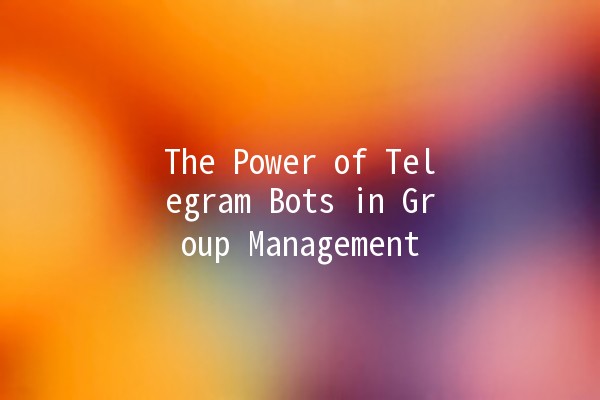The Power of Telegram Bots in Group Management 🤖💬

In the world of instant messaging, Telegram has carved a unique niche for itself, particularly with its vibrant community features such as channels and groups. What sets Telegram apart is the extensive use of bots—automated tools that can execute various tasks, enhance user experience, and streamline group management. In this article, we will explore the multifaceted world of Telegram bots used in group management, covering their benefits, types, installation processes, operational tips, and how they integrate deeply into community interactions.
Understanding Telegram Bots 🎉
What Are Telegram Bots?
Telegram bots are special accounts that run on the Telegram platform. They are powered by the Telegram Bot API, allowing developers to create applications that interact with users seamlessly. Bots can respond to messages, send notifications, and carry out automated commands based on user interactions. In a group setting, bots serve to make daily interactions smoother and more organized.
Why Use Bots in Telegram Groups?
The incorporation of bots into Telegram groups offers numerous advantages:
Automation: Bots handle repetitive tasks, freeing up group admins to engage more with community members.
Efficiency: They manage queries and frequent requests, leading to a more effective communication flow.
Customization: Bots can be tailored to meet the specific needs of a group, such as polls, quizzes, and reminders.

Engagement: Bots can facilitate interaction and keep group members engaged through games or interactive content.
Setting Up a Telegram Bot for Your Group 🚀
Creating Your Own Bot
To get started, you first need to create a bot using the BotFather, which is the official Telegram bot for bot creation and management.
Adding Your Bot to a Group
Once you have created your bot, you need to add it to your group:
Types of Telegram Bots for Group Management 🛠️
Moderation bots help maintain group decorum. They can delete inappropriate messages, kick out members who violate rules, and filter spam. These bots typically come with various settings that allow admins to customize their moderation levels.
Key Examples:
GroupHelp: A bot offering indepth moderation options for members and detailed logs of actions taken.
ModerationBot: This bot includes key phrase and user banning features.
These bots are designed to increase member engagement. They can facilitate games, quizzes, or even random discussions.
Key Examples:
QuizBot: Allows group members to create and participate in quizzes.
PollBot: Facilitates the creation of polls that enable members to vote on topics.
These bots are crucial for keeping group members updated. They can send reminders for events, share content, or notify about new messages or updates.
Key Examples:
ReminderBot: Enables users to set reminders and alerts for important events.
NewsBot: Sends updates from chosen channels or websites to group members.
Utility bots provide various helpful features like currency conversion, weather updates, or language translation within a group chat.
Key Examples:
WeatherBot: Offers weather forecasts based on user location.
CurrencyConverter: Simplifies the conversion of different currencies with realtime rates.
Enhancing Group Management with Bots 💡
Automating Tasks with Bots
The primary role of bots is to automate tasks. Here are some commonly automated actions:
Scheduling Posts: Bots can automate postings, reducing the need for manual updates.
Handling FAQs: Bots can store frequently asked questions and respond with preset answers.
Onboarding New Members: Automatically welcome new members, sending them group rules and important links.
Combing Bots for Collaborative Efforts
Using multiple bots together can enhance group management drastically. For instance, a moderation bot can work alongside a notification bot to manage interactions while keeping everyone informed about essential updates.
Best Practices for Using Bots in Telegram Groups 🌟
Align Bots with Group Objectives
Before implementing a bot, understand the primary purpose of your group. Different bots serve different needs, so pick ones that align with your group's objectives.
Customization is Key
Many bots offer customization options. Modify the settings and features to better fit your community style and requirements. This might include adjusting verbosity levels, modifying response times, or setting specific commands.
Monitor Bot Performance
Regularly assess how well a bot is serving your group. Gather feedback from group members and adjust functionalities accordingly.
Stay Updated
Bot features and Telegram's API evolve over time. Keep abreast of any updates to make the most of new features and capabilities that can further enhance your group’s interactivity.
Troubleshooting Common Issues with Bots ⚙️
Bot Not Responding
If a bot fails to respond, check if it has been muted or if its permissions have been altered in the group settings. Ensure that the bot is active on Telegram by verifying through BotFather.
Permissions Mismanagement
Sometimes bots may not function due to incorrect permission settings. Review the permissions each bot has and rectify any discrepancies.
Coding Issues
If you are developing a custom bot and encounter errors, use tools like the BotFather to troubleshoot or engage with Telegram's bot developer community for support.
RealLife Examples of Successful Bot Implementation ✨
Educational Groups
A university group implemented a QuizBot to engage students with quizzes relevant to their coursework. The participation rate increased significantly, creating an interactive learning environment.
Community Management
A large community group dealing with local events utilized a notification bot to keep members informed about upcoming activities. Attendance at events spiked due to timely reminders and news updates.
🌈
Utilizing bots in Telegram groups elevates the user experience and transforms group management dynamics. With various types of bots catering to different needs, from moderation to engagement, you can create a vibrant and interactive community that thrives on collaboration and effective communication.
As technology evolves, so will the capabilities of these bots, ensuring that Telegram remains at the forefront of online community engagement. Embrace the automation, leverage the innovations, and watch your group flourish like never before!
Other News

如何在TelegramX中进行群组投票 🤖📊

Telegram安装时间优化 🚀📱

Telegram Mac版下載地址及其特色功能探索!
